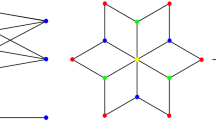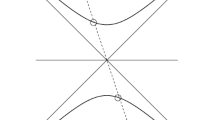Abstract
In this paper, we give a framework for the study of the extremal length geometry of Teichmüller space after S. Kerckhoff, F. Gardiner and H. Masur. There is a natural compactification using extremal length geometry introduced by Gardiner and Masur. The compactification is realized in a certain projective space. We develop the extremal length geometry in the cone which is defined as the inverse image of the compactification via the quotient mapping. The compactification is identified with a subset of the cone by taking an appropriate lift. The cone contains canonically the space of measured foliations in the boundary. We first extend the geometric intersection number on the space of measured foliations to the cone, and observe that the restriction of the intersection number to Teichmüller space is represented by an explicit formula in terms of the Gromov product with respect to the Teichmüller distance. From this observation, we deduce that the Gromov product extends continuously to the compactification. As an application, we obtain an alternative approach to a characterization of the isometry group of Teichmüller space. We also obtain a new realization of Teichmüller space, a hyperboloid model of Teichmüller space with respect to the Teichmüller distance.


Similar content being viewed by others
References
Bonahon, F.: Bouts des variétés hyperboliques de dimension \(3\). Ann. Math. 124(1), 71–158 (1986)
Bonahon, F.: The geometry of Teichmüller space via geodesic currents. Invent. Math. 92(1), 139–162 (1988)
Bridson, M., Haefliger, A.: Metric Spaces of Non-positive Curvature, Grundlehren der mathematischen Wissenschaften 319. Springer, Berlin (1999)
Douady, A., Fathi, A., Fried, D., Laudenbach, F., Poénaru, V., Shub, M.: Travaux de Thurston sur les surfaces, Séminaire Orsay, 2nd edn. Astérisque No. 66–67, Société Mathématique de France, Paris (1991)
Duchin, M., Leininger, C.J., Rafi, K.: Length spectra and degeneration of flat metrics. Invent. Math. 182, 231–277 (2010)
Earle, C., Gardiner, F.: Geometric isomorphisms between infinite dimensional Teichmüller spaces. Trans. Am. Math. Soc. 348, 1163–1190 (1996)
Earle, C., Kra, I.: On isometries between Teichmüller spaces. Duke Math. J. 41, 583–591 (1974)
Earle, C., Markovic, V.: Isometries between the spaces of \(L^1\) holomorphic quadratic differentials on Riemann surfaces of finite type. Duke Math. J. 120(2), 433–440 (2003)
Gardiner, F., Masur, H.: Extremal length geometry of Teichmüller space. Complex Var. Theory Appl. 16(2–3), 209–237 (1991)
Gromov, M.: Hyperbolic manifolds, groups and actions, Riemann surfaces and related topics. In: Proceedings of the 1978 Stony Brook Conference. Princeton University Press, pp. 182–213 (1981)
Hubbard, J., Masur, H.: Quadratic differentials and foliations. Acta Math. 142(3–4), 221–274 (1979)
Imayoshi, Y., Taniguchi, M.: Introduction to Teichmüller Spaces. Springer, Berlin (1992)
Ivanov, N.V.: Subgroups of Teichmüller modular groups, Translations of Mathematical Monographs, 115. American Mathematical Society, Providence, RI (1992)
Ivanov, N.: Isometries of Teichmüller spaces from the point of view of Mostow rigidity. In: Turaev, V., Vershik, A (eds.) Topology, Ergodic Theory, Real Algebraic Geometry. Am. Math. Soc. Transl. Ser. 2, vol. 202, American Mathematical Society, pp. 131–149 (2001)
Kerckhoff, S.: The asymptotic geometry of Teichmüller space. Topology 19, 23–41 (1980)
Korkmaz, M.: Automorphisms of complexes of curves on punctured spheres and punctured tori. Topol. Appl. 95, 85–111 (1999)
Lakic, N.: An isometry theorem for quadratic differentials on Riemann surfaces of finite genus. Trans. Am. Math. Soc. 349, 2951–2967 (1997)
Liu, L., Su, W.: The horofunction compactification of Teichmüller metric. In: Papadopoulos, A. (ed.) Handbook of Teichmüller theory, vol. IV, European Math. Society, Zürich, pp. 355–374 (2014)
Luo, F.: Automorphisms of the complexes and curves. Topology 39, 283–298 (2000)
Markovic, V.: Biholomorphic maps between Teichmüller spaces. Duke Math. 120, 405–431 (2003)
Masur, H.: On a class of geodesics in Teichmüller space. Ann. Math. 102, 205–221 (1975)
Masur, H.: Interval exchange transformations and measured foliations. Ann. Math. 115, 169–200 (1982)
Masur, H.: Geometry of Teichmüller space with the Teichmüller metric, Surveys in differential geometry, vol. XIV. Geometry of Riemann Surfaces and Their Moduli spaces. International Press, Somerville, MA, pp. 295–313 (2009)
Masur, H., Wolf, M.: Teichmüller space is not Gromov hyperbolic. Ann. Acad. Sci. Fenn. Math. 20, 259–267 (1995)
Masur, H., Wolf, M.: The Weil–Petersson isometry group. Geom. Dedic. 93, 177–190 (2002)
McCarthy, J., Papadopoulos, A.: The visual sphere of Teichmüller space and a theorem of Masur-Wolf. Ann. Acad. Sci. Fenn. Math. 24, 147–154 (1999)
Miyachi, H.: On the Gardiner-Masur boundary of Teichmüller spaces. In: Proceedings of the 15th ICFIDCAA Osaka 2007. OCAMI Studies, vol. 2, pp. 295–300 (2008)
Miyachi, H.: Teichmüller rays and the Gardiner-Masur boundary of Teichmüller space. Geom. Dedic. 137, 113–141 (2008)
Miyachi, H.: Teichmüller rays and the Gardiner-Masur boundary of Teichmüller space II. Geom. Dedic. 162, 283–304 (2013)
Miyachi, H.: Lipschitz algebra and compactifications of Teichmüller space. In: Papadopoulos, A. (ed.) Handbook of Teichmüller theory, vol. IV, European Math. Society, Zürich, pp. 375–413 (2014)
Minsky, Y.: Teichmüller geodesics and ends of hyperbolic 3-manifolds. Topology 32, 625–647 (1993)
Rees, M.: An alternative approach to the ergodic theory of measured foliations on surfaces. Ergodic Theory Dyn. Syst. 1(4), 461–488 (1981) (1982)
Rieffel, M.: Group \(C^*\)-algebra as compact quantum metric spaces. Doc. Math. 7, 605–651 (2002)
Royden, H.: Automorphisms and isometries of Teichmüller space. In: Advances in the Theory of Riemann Surfaces (Proc. Conf., Stony Brook, N.Y., 1969), Ann. Math. Studies, No. 66, Princeton University Press, Princeton, NJ, pp. 369–383 (1971)
Thurston, W.P.: On the geometry and dynamics of diffeomorphisms of surfaces. Bull. Am. Math. Soc. 19, 417–431 (1988)
Veech, W.: Gauss measures for transformations on the space of interval exchange maps. Ann. Math. 115, 201–242 (1982)
Walsh, C.: Private communication (2012)
Acknowledgments
The author thanks Professor Ken’ichi Ohshika and Professor Athanase Papadopoulos for stimulating and useful conversations and continuous encouragements. The author would like to express his heartfelt gratitude to Professor Francis Bonahon for his valuable suggestions and discussions and for his kind hospitality in the author’s visit at USC. The author thanks Professor Cormac Walsh for informing his example and for kindly permitting to put it in this paper. Finally, he is also grateful to the referee for his/her careful reading and for a number of helpful suggestions.
Author information
Authors and Affiliations
Corresponding author
Additional information
The author is partially supported by the Ministry of Education, Science, Sports and Culture, Grant-in-Aid for Scientific Research (C), 21540177.
Appendix: A proper geodesic metric space without extendable Gromov product
Appendix: A proper geodesic metric space without extendable Gromov product
This section is devoted to giving a geodesic metric space to which the Gromov product does not extend on the horofunction boundary. The following example is given by Cormac Walsh (cf. [37]). Notice that the Gardiner–Masur compactfication coincides with the horofunction compactification with respect to the Teichmüller distance (cf. [18]).
Let \(C_{n}\) be the frame \(\partial ([-n,n]\times [0,n])\) with the standard Euclidean metric. We construct a space \(X\) by gluing each frame \(C_{n}\) to \(\mathbb {R}\) along the bottom edge \([-n,n]\times \{0\}\) of \(C_{n}\) and the interval \([-n,n]\) of \(\mathbb {R}\) isometrically. The space \(X\) is a proper geodesic space (cf. Fig. 3).
Let \(b_{0}\), \(x^{1}_{n},y^{1}_{n},x^{2}_{n}\) and \(y^{2}_{n}\) be points in \(X\) corresponding to \(0\in \mathbb {R}\), \((-n,0)\), \((-n,n)\), \((n,0)\) and \((n,n)\) in \(C_{n}\) respectively. We consider \(b_{0}\) as the basepoint of \(X\). Then, one can see that for \(i=1,2\), \(\{x^{i}_{n}\}_{n}\) and \(\{y^{i}_{n}\}_{n}\) converges to the same Busemann point in the horofunction boundary of \(X\) though \(\{y^{i}_{n}\}_{n}\) is not an almost geodesic (cf. [33]). On the other hand, we see
while \(\langle x^{1}_{n}\,|\,x^{2}_{n}\rangle _{b_{0}}=(n+n-2n)/2=0\) for all \(n\).
Rights and permissions
About this article
Cite this article
Miyachi, H. Unification of extremal length geometry on Teichmüller space via intersection number. Math. Z. 278, 1065–1095 (2014). https://doi.org/10.1007/s00209-014-1346-y
Received:
Accepted:
Published:
Issue Date:
DOI: https://doi.org/10.1007/s00209-014-1346-y
Keywords
- Teichmüller space
- Teichmüller distance
- Extremal length
- Intersection number
- Gromov product
- Mapping class group





